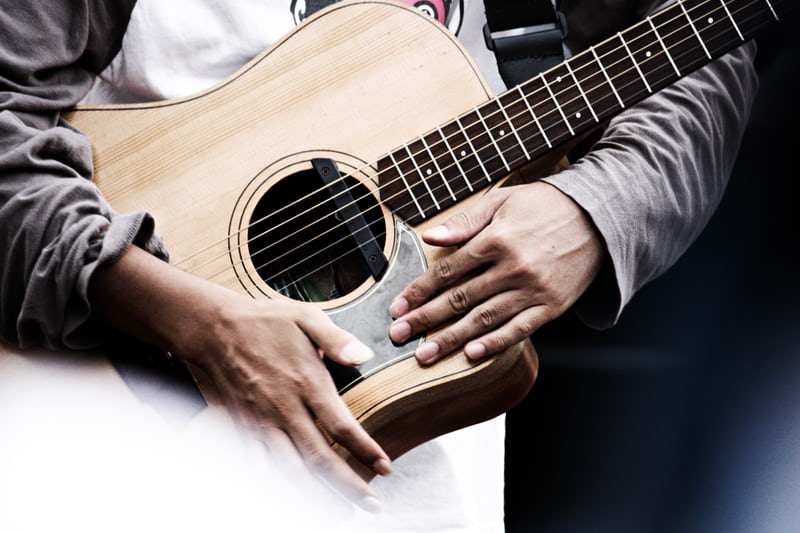
Every few weeks we try to highlight an artist.
Well, we received an email from Ben Tanner with the idea to teach our readers how to play a song on the guitar…
which will make YOU our inspiring artists for May.
Ben Tanner is a Physician’s Assistant (similar to a doctor), as well as a long-time guitar player and songwriter. Last year he started a website, Strummingly, with the goal of helping beginners learn basic guitar skills as painlessly as possible.
Here’s Ben and your very own Guitar lesson…

I’ve been playing guitar now for years. While I loved the instrument from the start, I still remember how overwhelmed I felt when I was first holding a guitar in my hands. Maybe you can relate.
I’m hoping to make the experience a bit less scary (and a lot more fun) with this guide for newbies.
Read on to learn how to start playing guitar as a total beginner.
Get the Right Instrument, Without Overspending
If you’re starting as a guitar player, there’s no need to invest big bucks in a pricey instrument.
In many cases, you can just borrow a guitar from a friend or family member.
If that’s not an option, you might consider renting from a music shop for a month or two until you’re confident this is the musical path you want to pursue.
If you’re intent on owning your guitar, it’s best to get one from a music store, not a flea market, yard sale, or pawn shop.
How come?
As a newbie, you probably don’t know what to look for in terms of quality and won’t recognize signs of damage.
A trusted local shop or reputable online retailer is a safe bet.
The pros there can advise you on options (e.g., electric versus classical versus acoustic) and let you try some with diverse price points, styles, conditions, and sizes.
Keep in mind there are a lot of different brands, but which one you get doesn’t really matter.
One affordable option for beginners are Yamaha acoustic guitars.
Learn How to Hold Your Guitar
While it can be tempting to stand up and sling your guitar like a rock-and-roll star, it’s easier to learn when sitting at the beginning. This also eliminates the need for a strap.
-
First, place your feet flat on the floor.
-
Then, rest the guitar’s waist atop your right leg.
-
Next, place your right arm over the body.
-
Finally, hold the neck in your left hand (so your hand comes up from below).
Got it? If not, check out the how-to video at the end of this article with Nate Savage. He goes over a few different options on how to hold a guitar.
Figure Out How to Hold the Guitar Pick
To hold the guitar pick, place the thumb and index finger of your strumming hand together. Curl the other three fingers inwards towards your palm.
The pick then goes between the index finger and thumb. The index finger should point down towards the pick’s tip without extending over the edge of the pick.
Know the Strings

A standard guitar has six strings.
Knowing which string is which is the first step when you start playing guitar. Each string is a musical note.
The strings are numbered 1 to 6, from thinnest to thickest. From the thickest to the thinnest string, the notes are as follows:
E A D G B E
(6 5 4 3 2 1)
There are some little tricks I used when I was starting to remember this. You might try “Eddie Ate Dynamite, Good Bye Eddie.”
Want something less violent?
How about “Elephants And Donkeys Grow Big Ears”?
Start With Basic Chords
With the above basics done, you’re finally ready to get started (who knew so much prep work would be needed before you’d play a single chord)!
But wait — what exactly is a chord, anyway?
A chord is just a combination of three or more musical notes (also called pitches), played together at once. Chords form the basis for most songs played on guitar.
So, there are four basic chords that everyone should learn when they start playing guitar.
First, let me say an essential word about frets. Frets are the raised “lines” on the neck of your guitar. To play the various chords, you will put different fingers on different frets. Read on to find how it’s done.
D Chord
Follow these 4 steps to play the D chord:
- Find the third string. Now, find the second fret. Put your index finger there.
- Find the first string. Now, find the second fret. Place your middle digit there.
- Find the second string. Now, find the third fret. Position your ring finger there.
- The fourth string stays open.
Strum across the bottom four strings with the pick.
Hear that sound? You’ve just played a D-chord.
C Chord
Follow these 3 steps to play the C chord:
- Find the second string. Now, find the first fret. Put your index finger there.
- Find the fourth string. Now, find the second fret. Position your middle finger on it.
- Find the fifth string. Now, find the third fret. Put your ring finger there.
Strum all the way across the bottom five strings with the pick.
You’ve just played a C-chord.
G Chord
Follow these 4 steps to play the G chord:
- Find the fifth string. Now, find the second fret. Place your middle finger there.
- Find the sixth string. Now, find the third fret. Position your ring finger there.
- Find the first string. Now, find the third fret. Place your pinky finger there.
- The second, third, and fourth strings stay open.
Strum all the strings with the pick.
You’ve just played a G-chord.
E-Minor Chord
Follow these 3 steps to play the E-Minor chord:
- Find the fifth string. Now, find the second fret. Place your index finger there.
- Find the fourth string. Now, find the second fret. Position your middle finger there.
- The first, second, third, and sixth strings remain open.
Strum across every string with the pick.
You’ve just played an E-minor chord.
Try Out a Full Song
Believe it or not, you can play a recognizable song with just those four chords described above (sometimes just 2 of 3 of them).
Guitar Player Box offers a list of songs you can play with just these chords. Check it out.
Playing a song is a great way to practice chord progressions (shifting from one chord to the next). Plus, let’s be honest, it’s also more fun!
When you play an actual song, you’re reminded that all that work of learning strings, notes, and chords allows you to create recognizable music.
Keep Learning More Chords

Okay, so you’ve got your basic four chords down. You’ve mastered a jingle or two. What now?
There are many more chords than the four described above. Start expanding your repertoire by learning additional chords.
This will also make it possible to play a greater diversity of songs.
Here is a primer to the essential guitar chords, complete with illustrations.
Practice, Practice, Practice
Holding the guitar and structuring your hand to play the various chords will probably feel awkward at first. I remember the hand positions felt unnatural to me at the beginning.
Give it time. That’s what practice is for.
Keep practicing your chords and incorporate them into songs like the one above regularly.
Soon enough, those “weird” chord positions will feel perfectly natural.
Even if you just practice 5 minutes per day, you’ll start to make some substantial progress.
Leave your guitar somewhere you’ll see it, and this will act as a reminder to practice just a little bit each day.
Know How to Tune Your Guitar
When you first bring your guitar home from the music shop, it will likely have been tuned for you. Still, you’ll need to keep up with regular tuning in between your practice sessions.
External factors like humidity and heat will cause strings to stretch and contract daily, gradually pushing your instrument out of tune.
There are smartphone apps that can help you tune your instrument. Just search “guitar tuner” in the app store, and you’ll find some good options.
The tuner app will indicate whether a string is “sharp” (higher than its intended musical note) or “flat” (lower). Then all you have to do is figure out which way to turn the knobs to adjust the string’s tone.
If you prefer, you could also buy a tuner. But a free app is usually good enough.
And you can also learn how to tune a guitar without a tuner. But that’s slightly more advanced.
How to Start Playing Guitar as a Newbie: The Final Word
I hope the above guide has made things a bit easier as you start playing guitar. Above all, I hope you’re enjoying yourself throughout this process.
Be patient and give yourself time to learn. Remember, this is all about having fun and building your skills.
We built 8 raised garden beds on the property that are used in our Ready to Work! Program, and along with the beautiful greenhouse we have onsite I like spending quiet time tending to whatever we happen to have growing.
Here’s the video by Nate Savage on how to hold a guitar:

The Show Must Go On(line): Quarantine Sessions We Love
While musicians have been hit pretty hard by the pandemic with postponed gigs and all venues currently closed, it doesn’t seem to be slowing down their creativity.
Connect With Us on Social Media!
RECENT FAVES
Tips for Hitting the Road with Your Furry Friends
Part 1 of Kathlene McGovern’s 2 part series on the best and safest ways to travel with your furry friends!
I’m Just Curious
Dove Rose give us ideas on how to stay curious! Keep it Fresh in the Kitchen, on the Drive and in your Life. New ideas to keep our mind alive!
Living Unhoused for a Week: Ken Craft Takes to the Streets
Ken Craft of Hope of the Valley lives unhoused on the streets of the San Fernando Valley for 100 hours and shares the challenges, insights and struggles he faced on this journey.




